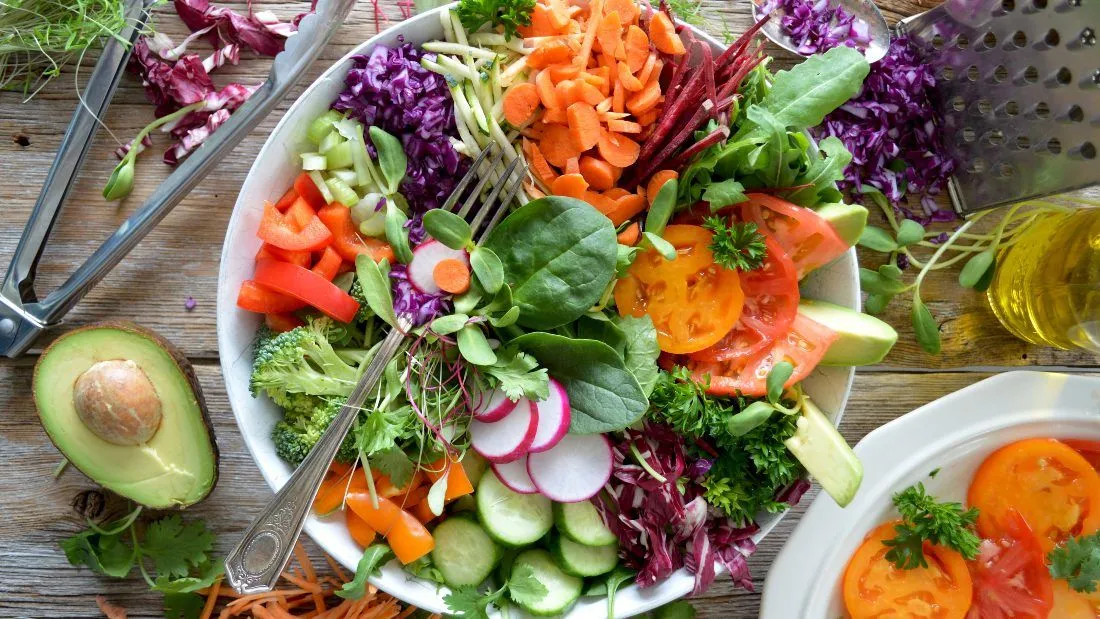Can you eat 30 plant foods a week?

… it might be easier than you think!
Some years ago, at a healthy eating conference I attended, a spokesperson for Public Health England presented convincing evidence that eating eight to 10 portions of fruit and veg a day offered significant health benefits, lowering the risk of all the big killer diseases such as obesity, diabetes, heart disease and cancer. But when summing up, she paused and said, but that would be considered unachievable for most people so we just recommend five a day.
The 5-A-Day campaign has since become very well-known but it’s not so good if you eat the same five fruit and veg every day.
A new challenge, which you may not yet have heard of, is the 30-Plant Challenge, encouraging you to eat 30 different plant foods each week. That might sound unachievable but it equates to just over four new items a day.
The idea is straightforward; every ‘new’ plant food you eat in a given week counts as one more towards your ultimate goal of 30. When you achieve that number, you will almost certainly be eating the broad spectrum of different nutrients required to keep your body – particularly the community of bacteria that live in your gut (microbiome), healthy.
Gut bacteria are just like people in that they have preferences for certain foods. The more plant foods you feed them, the more diverse and beneficial your microbiome becomes. Conversely, people who eat diets high in animal protein can suffer harmful changes in their gut bacteria, increasing the risk of inflammatory bowel disease (IBD) and other health problems.
The idea came from research carried out as part of the American Gut Project, a crowd-sourced project that set out to better understand the role of the gut microbiome. In this largest microbiome study to date, over 10,000 participants from the US, UK and Australia posted a sample of their poo to laboratories so that researchers could find out what differences their diets made.
They found that the microbiomes of those eating more than 30 different plant foods per week were more diverse than those who ate 10 or fewer per week. It’s because plants contain substances called prebiotics, which provide fuel for the ‘good’ bacteria in your gut. The health benefits of a diverse microbiome extend far beyond protecting your digestion; it’s thought to look after your immune system, reduce inflammation and regulate many other body functions, helping you stay healthy and happy. Your gut microbiome is critical for good health.
Those eating 30 or more plant foods a week also had fewer antibiotic resistance genes in their gut than people who ate 10 or fewer plants. It’s possible that eating fewer plants equates to eating more meat from farmed animals treated with antibiotics.
Which plants count?
Beneficial plants can be divided into six groups known as the Super Six:
- Wholegrains: brown rice, oats, quinoa, wholemeal bread, wholewheat pasta
- Vegetables: asparagus, beetroot, broccoli, cabbage, carrots, onion, peppers, rocket, spinach, sweet potato
- Fruit: apple, avocado, banana, blueberries, mango, orange, papaya, raspberries, tomatoes
- Pulses: black beans, chickpeas, kidney beans, lentils, peas, soya foods (edamame, tempeh and tofu)
- Nuts and seeds: almonds, Brazil nuts, cashews, chia seeds, flaxseeds, pistachios, pumpkin seeds, sunflower seeds, sesame seeds, walnuts
- Herbs and spices: basil, black pepper, coriander, dill, ginger, mint, oregano, parsley, rosemary, thyme, turmeric
All these count but only once each week. Fresh, dried, tinned and frozen plants all count but choose those with no added salt or sugar. We eat herbs and spices only in small amounts so they’re worth around a quarter of a point so use them several times a week. It’s variety rather than volume!
Some very similar foods can be counted separately, such as red and green peppers as they contain different levels of nutrients. Soya foods such as edamame, tofu and tempeh can all be counted separately for the same reason. Tea and coffee can also be included but these, too, count only as one-quarter. Chocolate, in moderation, also counts but it needs to be the dark variety – 70 per cent cocoa or above.
What doesn’t count?
Foods that have been highly processed and lost many of their natural nutrients don’t count – white bread, white pasta and white rice, for example. Wholemeal bread, wholewheat pasta and brown rice, on the other hand, do count. Unlike with 5-A-Day, processed fruit juice is also out as it has lost its natural fibre.
To up your numbers if you’re not vegan, replace meat, fish and eggs with tofu, tempeh or beans. If you are vegan, swap the more processed foods for wholefoods – swap soya mince with brown lentils or vegan ‘fish’ fingers with tofish fingers! Viva!’s Vegan Recipe Club has lots of exciting recipes to help you make these switches.
If you already eat a wholefood vegan diet, focus on increasing the variety – sweet potatoes instead of spuds, a variety of green vegetables rather than just your old favourites. Kale, spinach, broccoli and cabbage all have a unique range of nutrients, or try samphire, pak choy, red cabbage, Romanesco (fractal) cauliflower, radicchio or whatever catches your eye!
To supercharge your meals try adding berries to cereal or porridge; sprinkle seeds on soups and salads, add spinach to dahl, sneak salad leaves into your sandwich and nibble a few nuts in the afternoon. If you’re replacing calorie-dense foods with fresh fruit, veggies, pulses and so on, you may even lose a few pounds along the way but tread carefully with chocolate and nuts!
With just a bit of effort over the last three days, I’ve hit 26 plant foods already – the Mexican salsa with mango, red onion, red pepper, cucumber and coriander was a super-booster as was the fruit salad with fresh mint. Give it a go! Researchers say that eating across the Super Six may add as much as a decade of healthy years to your life.




